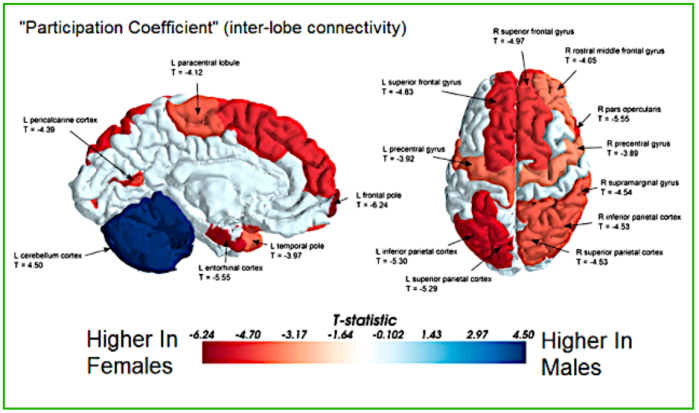PREVIOUS: M vs F brain (#1)
SITE: Questionnaire (64 Qs) –“Kind Of Brain – M or F? ”
Combined RESULTS
NO Differences? : Researchers at the U of Tel-Aviv categorized brain structures into M or F zones, & one common to both – a mosaic – focusing on traits that showed the biggest gender disparity.
 They noted that extremes are rare – only 6% of the subjects were more M or more F, based on analyses of several sets of data. Overall, results show that human brains don’t usually belong to just one type or the other, even though specific parts do show gender differences. (More….)
They noted that extremes are rare – only 6% of the subjects were more M or more F, based on analyses of several sets of data. Overall, results show that human brains don’t usually belong to just one type or the other, even though specific parts do show gender differences. (More….)
Many recent imaging techniques, such as studies at the U of Penn, confirm that Ms & Fs are indeed “hard-wired” differently. Scientists have discovered almost 100 variances, so this reality can not be over-stated.
HEMISPHERES
While all parts interact, each has a main focus. In general:
▪︎ FRONT part of brain handles action
▪︎ BACK deals with perception (aware of something via the senses)
▪︎ RIGHT provides intuitive thinking
▪︎ LEFT provides logical thinking
Male: Typical connections are between front & back areas, mainly confined to each hemisphere separately (blue). This is why men tend get irritated when having to do several things at the same time.
Exception: The only region they showed L-R connections was in the cerebellum, which governs muscle movement, providing good motor control.
So – males are wired more for perception & co-ordinated actions, while…..
Female: ….. processes are mainly back & forth across the meridian (corpus collosum) between the L & R sides (red)
So – females are wired for social skills, memory, & being more emotionally involved.
 ▪︎ Because L brain is logical & R is intuitive, Fs are hardwired for multi-tasking. Since they use both sides – when an activity requires both abilities they can more quickly transition between activities
▪︎ Because L brain is logical & R is intuitive, Fs are hardwired for multi-tasking. Since they use both sides – when an activity requires both abilities they can more quickly transition between activities
And older Fs showed more widely distributed connections throughout the brain, rather than just in the frontal lobe.
NOTE: M & F fetuses start showing brain differences at around 26 weeks – when Fs usually start developing a thicker corpus callosum, which may explain why women tend to use both hemispheres.
RESTING BRAIN
IMP: Research (Slovenia, 2000) on 300 volunteers using EEG & hemodynamic principles, was based on resting eyes, ie. closed brain activity.
Results showed Ms & Fs differ significantly in the default mode, a complex pattern suggesting that variations in their behavior might come from the activity of the resting brain. (⬇️ Images from Amen Clinic)
Each person’s brain is an intricate & unique system of neural pathways connecting multiple networks in the cerebrum to several sub-networks in the cerebellum. The mysterious, powerful cerebellum is only 10% of brain volume, but houses over 50% of our brain’s total neurons (brain cells).
The Gurs’ studies on the resting brain found
— M activity occurred more in the amygdala, primed to react physically
— Fs’ comes from the cingulate gyrus, in the limbic emotional system, primed to react verbally
Brain SIZE
M – Typically, M brains are 11-12% bigger than women – (average weight = 3lbs) & have more volume in 14 sub-cortical regions – relative to overall brain size. This makes sense, since generally the M body is 10% larger, so it needs more neurons to control its greater bulk & muscle mass.
Also, volume & cortical thickness among Ms tended to vary much more than among Fs. INTERESTING: With age, the M brain shrinks faster
F – Although women’s brains are 10% smaller than men’s, they use their brain more efficiently. And they have higher brain volumes than men in 10 sub-cortical regions. Average weight = 2.75lbs
CORTEX – the executive-function system
F: It’s significantly thicker & slightly more convoluted (more area), Neurons are more densely crowded on layers responsible for signals coming in & out. The prefrontal cortex is larger & matures faster in women, with fewer but larger neuronal units.
M: Their brains have more numerous but smaller neuronal units.
Larger: the parietal cortex (space perception) & the amygdala (sex)
IMAGE from another U of Penn study, ⬆️ which shows pronounced differences between the sexes during various activities, most obvious at ages 12-14.
NEXT: M vs F #3



